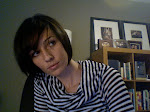When I wrote my novel, the thought of a second draft (and the looming possibility of a third) was so intimidating that I didn't even bother. I blazed through the first draft in a month for NaNoWriMo 2006 and it's been sitting there, gathering dust for a year and a half.
Writing a 50,000-word novel in 30 days is more about quantity than quality, obviously. And it follows my philosophy about shitty first drafts. But the catch is, shitty first drafts need to lead to seconds and then to thirds. How that process happens is a bit of a mystery. I can't even be sure that what I did on my screenplay counts as a true second draft. If there is such a thing in the first place.
My first draft was a broad-strokes vomit of scenes, dialogue and character. As I wrote, I figured out (roughly) who these people are, what their problems are and where they are trying to go. On the page was mostly bad dialogue with enough scene description to get a sense of what was going on.
What I've been calling Version 1.5 was a polishing of the first, adding a few more layers to the skeleton. Bad generic-sounding dialogue became dialogue that this character might actually say (if they were highly sedated). I started thinking about how these people look (she's a rockabilly girl and he wears Banana Republic v-necks) and some internal opposition (he's really lonely, but is intentionally mean to everyone).
Version 2.0 was all about creating the world of the screenplay. I pared down the dialogue and explored how everything looked and felt from the rusty, dusty beater Claire drives to the yellowing paint on her walls. And although Dana the Artist advised me to write "like a miser sending a telegram to a four-year-old", I think the overlong descriptions of this draft taught me about how the outside of a character's world gives us access to their insides.
It was after Version 2.0 that I allowed people to read the thing. Only one has returned with feedback (good, usable feeback in fact), but I can't wait around for more. My third draft is already pushing on my chest, just like the second one did. I want out, it says. Let me at it. My characters are begging me to sit with them some more. They have more to tell me about who they are...their subtleties and contradictions. Their deepest desires. They are tugging on my sleeve again, whispering, "Listen."
Screenplays that Have Rocked My World in the Last Few Months:
- Margot at the Wedding (laser-sharp characters and dialogue)
- The Station Agent (spare dialogue, beautiful characters, starring "my" dwarf, Peter Dinklage)
- Lars and the Real Girl (how to make a ridiculous scenario totally believable)
- The Savages (specific, subtle, nuanced characters, beautiful storytelling)
- Juno (smart-assed, punchy dialogue)
- Away From Her (lyrical and poetic)
- Death at a Funeral (a great example of escalating drama and high stakes)

No comments:
Post a Comment